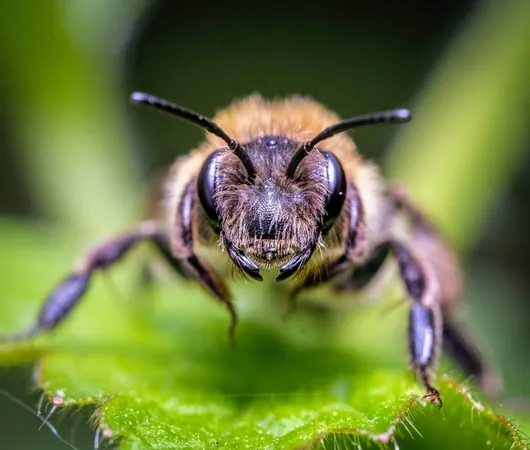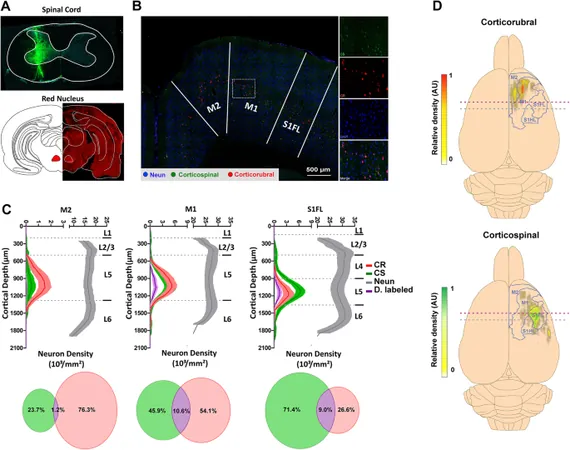
Tiny Fossil Thrills Scientists, Redefining Arthropod Ancestry!
2025-08-31
Author: Amelia
Over 500 million years ago, a minuscule ancestor of modern arthropods scuttled across the ancient sea floor in present-day Yunnan, China. This remarkable creature, known as Jianfengia multisegmentalis, boasted large grasping arms, stalked eyes, and a surprisingly sophisticated brain nestled within a head no wider than a pencil tip.
Arthropods: The Rulers of the Animal Kingdom
From insects to crabs and spiders, arthropods reign supreme, with over a million known species thriving in oceans, on land, in the air, and even inside other animals. Their incredible survival skills are attributed to their tough exoskeletons, segmented bodies, and jointed appendages, with a lineage dating back over 500 million years.
The Great Arthropod Split: Unraveling Evolutionary Mysteries
Despite their dominance, one question has perplexed scientists: the origin of the two main branches of arthropods. On one side, the mandibulates— including insects, crustaceans, and millipedes—feature jaws or mandibles for feeding. The other side comprises chelicerates, like spiders and scorpions, equipped with pincers instead.
A Groundbreaking Discovery: Jianfengia's Unexpected Secrets
Initially classified among megacheirans, meaning "large hands" in Greek, Jianfengia was believed to share characteristics with chelicerates due to its long, claw-like limbs. However, a closer examination of its fossilized brain revealed surprising similarities to modern shrimp and crayfish minds.
Revealing the Ancient Ancestors of Antennae
Lead researcher Nicholas Strausfeld highlighted that Jianfengia lacked common crustacean sensory appendages, hinting that its huge appendages were actually the precursors to the antennae seen in today’s arthropods.
Astonishing Sensory Capabilities
Despite its small head, measuring a mere 0.08 inches, Jianfengia was packed with sensory capability. Featuring stalked compound eyes and additional single-lens eyes, it showcased an astonishing level of detail rarely seen in fossils of such antiquity. Thanks to fortuitous conditions during fossilization, even delicate neural structures were preserved.
Diverging Evolutionary Paths
Another notable specimen, Alalcomenaeus, shared a similar outer appearance with Jianfengia but boasted a brain resembling that of the horseshoe crab, revealing its affiliation with the chelicerate lineage. This shows that external similarities do not always reflect underlying evolutionary relationships.
The Evolutionary Legacy of Claws
The large appendages of these ancient creatures underwent significant transformation over millions of years. In chelicerates, they morphed into spider fangs, while in mandibulates, they evolved into segmented antennae. Modern ostracods with claspers serve as living reminders of this evolutionary journey.
Unlocking Arthropod Evolution Through Neural Analysis
Shaping our understanding of arthropods, the study emphasizes the importance of analyzing fossilized brains to unravel evolutionary connections that physical features alone cannot reveal. As Frank Hirth from King’s College London points out, the brain structures of these fossils closely align with those of contemporary arthropods, highlighting their evolutionary resilience.
Conclusion: A Tiny Brain, A Huge Breakthrough!
Ultimately, the diminutive brain of this ancient marine creature has cracked one of evolution's oldest riddles, shedding light on the branching of the arthropod family tree. The groundbreaking findings were published in the journal Nature Communications, igniting excitement in the scientific community and beyond.









 Brasil (PT)
Brasil (PT)
 Canada (EN)
Canada (EN)
 Chile (ES)
Chile (ES)
 Česko (CS)
Česko (CS)
 대한민국 (KO)
대한민국 (KO)
 España (ES)
España (ES)
 France (FR)
France (FR)
 Hong Kong (EN)
Hong Kong (EN)
 Italia (IT)
Italia (IT)
 日本 (JA)
日本 (JA)
 Magyarország (HU)
Magyarország (HU)
 Norge (NO)
Norge (NO)
 Polska (PL)
Polska (PL)
 Schweiz (DE)
Schweiz (DE)
 Singapore (EN)
Singapore (EN)
 Sverige (SV)
Sverige (SV)
 Suomi (FI)
Suomi (FI)
 Türkiye (TR)
Türkiye (TR)
 الإمارات العربية المتحدة (AR)
الإمارات العربية المتحدة (AR)